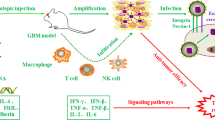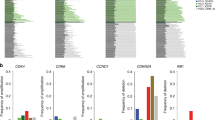Abstract
Glioblastoma multiforme (GBM) is the most aggressive type of all primary brain tumors, with an overall median survival <1 year after diagnosis. Despite introduction of multimodal treatment approaches, the prognosis has not improved significantly over the past 50 years. In this study we investigated the effect of intracerebroventricular (ICV) injection of an adeno-associated virus (AAV) vector encoding human interferon-β (AAV-hIFN-β) on glioblastoma growth. Recently, we found that peritumoral parenchymal transduction with an AAV-hIFN-β was exceptionally efficient in eradicating GBM brain tumors. However, the extensive infiltration and migration displayed by glioblastoma cells in patients may leave a significant number of tumor cells outside a local therapeutic zone created by intraparenchymal delivery of AAV vectors. Here we show that pretreatment of mice by ICV infusion of an AAV-IFN-β completely prevents tumor growth in an orthotopic model of GBM. Furthermore, ICV infusion of AAV-IFN-β into mice bearing preestablished U87 intracranial tumors improved their survival compared to mice infused through the same route with a control AAV vector. These data suggest that ICV injection of AAV vectors encoding antitumor proteins is a promising approach deserving further consideration for the treatment of GBM.
This is a preview of subscription content, access via your institution
Access options
Subscribe to this journal
Receive 12 print issues and online access
$259.00 per year
only $21.58 per issue
Buy this article
- Purchase on Springer Link
- Instant access to full article PDF
Prices may be subject to local taxes which are calculated during checkout




Similar content being viewed by others
References
Sathornsumetee S, Rich JN . New treatment strategies for malignant gliomas. Expert Rev Anticancer Ther 2006; 6: 1087–1104.
Jain RK, Baxter LT . Mechanisms of heterogeneous distribution of monoclonal antibodies and other macromolecules in tumors: significance of elevated interstitial pressure. Cancer Res 1988; 48 (24 Pt 1): 7022–7032.
Jain RK, di Tomaso E, Duda DG, Loeffler JS, Sorensen AG, Batchelor TT . Angiogenesis in brain tumours. Nat Rev Neurosci 2007; 8: 610–622.
Maguire CA, Meijer DH, Leroy SG, Tierney LA, Broekman ML, Costa FF et al. Preventing growth of brain tumors by creating a zone of resistance. Mol Ther 2008; 16: 1695–1702.
Giese A, Westphal M . Glioma invasion in the central nervous system. Neurosurgery 1996; 39: 235–250; discussion 250–252.
Laws Jr ER, Goldberg WJ, Bernstein JJ . Migration of human malignant astrocytoma cells in the mammalian brain: Scherer revisited. Int J Dev Neurosci 1993; 11: 691–697.
Bashir R, Hochberg F, Oot R . Regrowth patterns of glioblastoma multiforme related to planning of interstitial brachytherapy radiation fields. Neurosurgery 1988; 23: 27–30.
Hochberg FH, Pruitt A . Assumptions in the radiotherapy of glioblastoma. Neurology 1980; 30: 907–911.
Wallner KE, Galicich JH, Krol G, Arbit E, Malkin MG . Patterns of failure following treatment for glioblastoma multiforme and anaplastic astrocytoma. Int J Radiat Oncol Biol Phys 1989; 16: 1405–1409.
Bankiewicz KS, Eberling JL, Kohutnicka M, Jagust W, Pivirotto P, Bringas J et al. Convection-enhanced delivery of AAV vector in parkinsonian monkeys; in vivo detection of gene expression and restoration of dopaminergic function using pro-drug approach. Exp Neurol 2000; 164: 2–14.
Bankiewicz KS, Forsayeth J, Eberling JL, Sanchez-Pernaute R, Pivirotto P, Bringas J et al. Long-term clinical improvement in MPTP-lesioned primates after gene therapy with AAV-hAADC. Mol Ther 2006; 14: 564–570.
Cunningham J, Pivirotto P, Bringas J, Suzuki B, Vijay S, Sanftner L et al. Biodistribution of adeno-associated virus type-2 in nonhuman primates after convection-enhanced delivery to brain. Mol Ther 2008; 16: 1267–1275.
Liu G, Martins I, Wemmie JA, Chiorini JA, Davidson BL . Functional correction of CNS phenotypes in a lysosomal storage disease model using adeno-associated virus type 4 vectors. J Neurosci 2005; 25: 9321–9327.
Watson G, Bastacky J, Belichenko P, Buddhikot M, Jungles S, Vellard M et al. Intrathecal administration of AAV vectors for the treatment of lysosomal storage in the brains of MPS I mice. Gene Therapy 2006; 13: 917–925.
Gao G, Vandenberghe LH, Alvira MR, Lu Y, Calcedo R, Zhou X et al. Clades of adenoassociated viruses are widely disseminated in human tissues. J Virol 2004; 78: 6381–6388.
Cearley CN, Vandenberghe LH, Parente MK, Carnish ER, Wilson JM, Wolfe JH . Expanded repertoire of AAV vector serotypes mediate unique patterns of transduction in mouse brain. Mol Ther 2008; 16: 1710–1718.
Broekman ML, Comer LA, Hyman BT, Sena-Esteves M . Adeno-associated virus vectors serotyped with AAV8 capsid are more efficient than AAV-1 or -2 serotypes for widespread gene delivery to the neonatal mouse brain. Neuroscience 2006; 138: 501–510.
Viloria-Petit A, Crombet T, Jothy S, Hicklin D, Bohlen P, Schlaeppi JM et al. Acquired resistance to the antitumor effect of epidermal growth factor receptor-blocking antibodies in vivo: a role for altered tumor angiogenesis. Cancer Res 2001; 61: 5090–5101.
Chang M, Cooper JD, Sleat DE, Cheng SH, Dodge JC, Passini MA et al. Intraventricular enzyme replacement improves disease phenotypes in a mouse model of late infantile neuronal ceroid lipofuscinosis. Mol Ther 2008; 16: 649–656.
Dickson P, McEntee M, Vogler C, Le S, Levy B, Peinovich M et al. Intrathecal enzyme replacement therapy: successful treatment of brain disease via the cerebrospinal fluid. Mol Genet Metab 2007; 91: 61–68.
Indraccolo S, Pfeffer U, Minuzzo S, Esposito G, Roni V, Mandruzzato S et al. Identification of genes selectively regulated by IFNs in endothelial cells. J Immunol 2007; 178: 1122–1135.
Izawa JI, Sweeney P, Perrotte P, Kedar D, Dong Z, Slaton JW et al. Inhibition of tumorigenicity and metastasis of human bladder cancer growing in athymic mice by interferon-beta gene therapy results partially from various antiangiogenic effects including endothelial cell apoptosis. Clin Cancer Res 2002; 8: 1258–1270.
Odaka M, Sterman DH, Wiewrodt R, Zhang Y, Kiefer M, Amin KM et al. Eradication of intraperitoneal and distant tumor by adenovirus-mediated interferon-beta gene therapy is attributable to induction of systemic immunity. Cancer Res 2001; 61: 6201–6212.
Derynck R, Remaut E, Saman E, Stanssens P, De Clercq E, Content J et al. Expression of human fibroblast interferon gene in Escherichia coli. Nature 1980; 287: 193–197.
Agha-Mohammadi S, O’Malley M, Etemad A, Wang Z, Xiao X, Lotze MT . Second generation tetracycline-regulatable promoter: repositioned tet operator elements optimize transactivator synergy while shorter minimal promoter offers tight basal leakiness. J Gene Med 2004; 6: 817–828.
Fitzsimons HL, McKenzie JM, During MJ . Insulators coupled to a minimal bidirectional tet cassette for tight regulation of rAAV-mediated gene transfer in the mammalian brain. Gene Therapy 2001; 8: 1675–1681.
Jiang L, Rampalli S, George D, Press C, Bremer EG, O’Gorman MR et al. Tight regulation from a single tet-off rAAV vector as demonstrated by flow cytometry and quantitative, real-time PCR. Gene Therapy 2004; 11: 1057–1067.
Ye X, Rivera VM, Zoltick P, Cerasoli Jr F, Schnell MA, Gao G et al. Regulated delivery of therapeutic proteins after in vivo somatic cell gene transfer. Science 1999; 283: 88–91.
Kaempfer R . Interferon-gamma mRNA attenuates its own translation by activating PKR: a molecular basis for the therapeutic effect of interferon-beta in multiple sclerosis. Cell Res 2006; 16: 148–153.
Acknowledgements
This work was supported by a Young Investigator Award from the Alliance for Cancer Gene Therapy (MSE), and NIH 5 T32 CA073479-09 (CM). We acknowledge the Massachusetts General Hospital Neuroscience Center Microscopy and Image Analysis Core (NIH grant P30NS045776) for the use of the Nikon scanner, and we thank Dr Ralph Weissleder, Director of the Center for Molecular Imaging Research, for the use of the bioluminescence imager.
Author information
Authors and Affiliations
Corresponding author
Additional information
Supplementary Information accompanies the paper on Cancer Gene Therapy website (http://www.nature.com/cgt)
Supplementary information
Rights and permissions
About this article
Cite this article
Meijer, D., Maguire, C., LeRoy, S. et al. Controlling brain tumor growth by intraventricular administration of an AAV vector encoding IFN-β. Cancer Gene Ther 16, 664–671 (2009). https://doi.org/10.1038/cgt.2009.8
Received:
Revised:
Accepted:
Published:
Issue Date:
DOI: https://doi.org/10.1038/cgt.2009.8
Keywords
This article is cited by
-
Clinical features and prognostic significance of tumor involved with subventricular zone in pediatric glioblastoma: a 10-year experience in a single hospital
Child's Nervous System (2022)
-
Viral vector: potential therapeutic for glioblastoma multiforme
Cancer Gene Therapy (2020)
-
Intravenous injection of AAV-PHP.eB across the blood-brain barrier in the adult mouse for central nervous system gene therapy*
Oncology and Translational Medicine (2019)
-
CNS-Wide over Expression of Fractalkine Improves Cognitive Functioning in a Tauopathy Model
Journal of Neuroimmune Pharmacology (2019)
-
Virus vector-mediated genetic modification of brain tumor stromal cells after intravenous delivery
Journal of Neuro-Oncology (2018)



